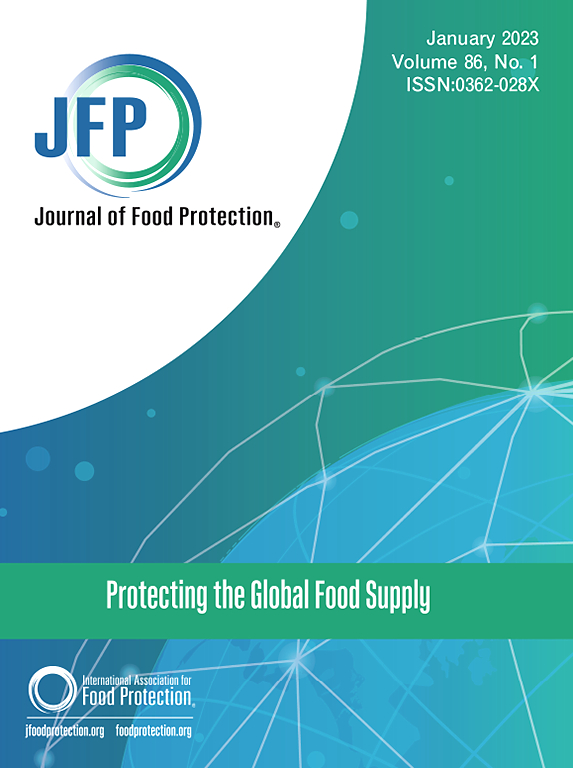Reduction of Enteric Pathogens in Bottled Water Using Residual Ozone
IF 2.8
4区 农林科学
Q3 BIOTECHNOLOGY & APPLIED MICROBIOLOGY
引用次数: 0
Abstract
Ozone is an effective and safe disinfectant used globally in the bottled water industry. Ozone infusion at a high level helps maintain a residual level (0.1–0.4 mg/L) at the time of bottling, thus can ensure 4 log microbial reductions. This study validated the efficacy of residual ozone against Escherichia coli O157:H7, non-O157 Shiga toxin-producing E. coli (STEC; O26, O45, O103, O111, O121, O145), and Salmonella Typhimurium. A pilot-scale ozone system infused 0.5 L polyethylene terephthalate (PET) bottles with ozonated water (0.1–0.4 mg/L). Pathogens were inoculated into samples (∼6 or 4 log CFU/mL) immediately after ozonation treatment, followed by incubation at 25 °C for 5–180 min. Additional trials evaluated the isolated effect of pH (5.0, 7.0, and 9.0) and total dissolved solids (TDS; 5, 50, and 500 mg/L) at a fixed ozone concentration (0.1 mg/L ozone) and contact time (30 min). Posttreatment samples were neutralized (0.1% sodium thiosulfate), filtered, and plated on Petri films for enumeration (35 °C, 48 h). Neutralization (0.1% sodium thiosulfate) was validated to have no antimicrobial effect in controls. All pathogens exhibited ≥4 log reductions across ozone concentrations (0.1–0.4 mg/L), contact times (≥5 min), and inoculum levels (6 or 4 log CFU/mL). Extended contact (30–180 min) did not enhance reduction. However, at 500 mg/L TDS, reductions fell below 4 logs: Salmonella (2.60 log ± 1.24), E. coli O157:H7 (1.72 log ± 1.10), and non-O157 STEC (2.74 log ± 1.45). Similarly, pH 5.0 and 9.0 resulted in <4 log reductions. While residual ozone effectively achieves microbial safety benchmarks, elevated TDS and nonneutral pH significantly impair efficacy. These findings underscore the necessity of monitoring water quality parameters to optimize ozone disinfection in bottled water facilities, ensuring consistent compliance with food safety standards.
利用残余臭氧减少瓶装水中的肠道致病菌。
臭氧是全球瓶装水行业使用的一种有效、安全的消毒剂。高水平的臭氧注入有助于在装瓶时保持残留水平(0.1 -0.4 mg/L),从而可以确保4 log微生物减少。本研究验证了残留臭氧对大肠杆菌O157:H7、非O157产志贺毒素大肠杆菌(STEC;O26、O45、O103、O111、O121、O145)和鼠伤寒沙门氏菌。一个中试规模的臭氧系统向0.5 L聚乙烯对苯二甲酸乙二醇酯(PET)瓶注入臭氧化水(0.1-0.4 mg/L)。在臭氧化处理后,将病原体立即接种到样品中(~ 6或4 log CFU/mL),然后在25°C下孵育5-180分钟。另外的试验评估了pH(5.0, 7.0, 9.0)和总溶解固体(TDS;5、50、500 mg/L),固定臭氧浓度(0.1 mg/L臭氧)和接触时间(30 min)。处理后的样品被中和(0.1%硫代硫酸钠),过滤,并镀在Petri膜上计数(35°C, 48 h)。中和剂(0.1%硫代硫酸钠)在对照组中被证实无抗菌作用。所有病原体在臭氧浓度(0.1-0.4 mg/L)、接触时间(≥5分钟)和接种量(6或4 log CFU/mL)上均表现出≥4对数的降低。延长接触时间(30-180分钟)没有增强复位。然而,在500 mg/L TDS下,减少量低于4log:沙门氏菌(2.60 log±1.24),大肠杆菌O157:H7 (1.72 log±1.10)和非O157 STEC (2.74log±1.45)。类似地,pH 5.0和9.0导致
本文章由计算机程序翻译,如有差异,请以英文原文为准。
求助全文
约1分钟内获得全文
求助全文
来源期刊

Journal of food protection
工程技术-生物工程与应用微生物
CiteScore
4.20
自引率
5.00%
发文量
296
审稿时长
2.5 months
期刊介绍:
The Journal of Food Protection® (JFP) is an international, monthly scientific journal in the English language published by the International Association for Food Protection (IAFP). JFP publishes research and review articles on all aspects of food protection and safety. Major emphases of JFP are placed on studies dealing with:
Tracking, detecting (including traditional, molecular, and real-time), inactivating, and controlling food-related hazards, including microorganisms (including antibiotic resistance), microbial (mycotoxins, seafood toxins) and non-microbial toxins (heavy metals, pesticides, veterinary drug residues, migrants from food packaging, and processing contaminants), allergens and pests (insects, rodents) in human food, pet food and animal feed throughout the food chain;
Microbiological food quality and traditional/novel methods to assay microbiological food quality;
Prevention of food-related hazards and food spoilage through food preservatives and thermal/non-thermal processes, including process validation;
Food fermentations and food-related probiotics;
Safe food handling practices during pre-harvest, harvest, post-harvest, distribution and consumption, including food safety education for retailers, foodservice, and consumers;
Risk assessments for food-related hazards;
Economic impact of food-related hazards, foodborne illness, food loss, food spoilage, and adulterated foods;
Food fraud, food authentication, food defense, and foodborne disease outbreak investigations.
 求助内容:
求助内容: 应助结果提醒方式:
应助结果提醒方式:


